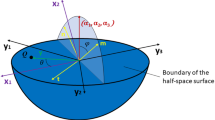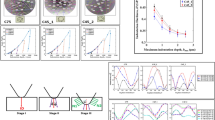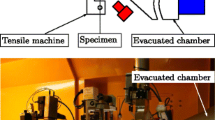Abstract
Microcompression test was applied to determine the Young’s modulus for elastically anisotropic materials for two different orientations of single crystalline Si. Although there is a clear difference in the apparent Young’s moduli for the different orientations, a significant underestimation of Young’s modulus was observed resulting from the substrate deformation as observed in both finite element simulation and experiment. This effect decreases with increasing aspect ratio. To correct the deviation of the apparent Young’s modulus from the theoretical values, a systematic framework of microcompression test is suggested. The modified Sneddon correction using the indentation modulus instead of Young’s modulus successfully yields Young’s moduli of single crystalline silicon in the [100] and [111] directions to within 5.3% and 2.0% deviation, respectively.










Similar content being viewed by others
References
W.C. Oliver and G.M. Pharr: Measurement of hardness and elastic modulus by instrumented indentation: Advances in understanding and refinements to methodology. J. Mater. Res. 19, 3 (2004).
J.J. Vlassak and W.D. Nix: Measuring the elastic properties of anisotropic materials by means of indentation experiments. J. Mech. Phys. Solids 42, 1223 (1994).
J.J. Vlassak, M. Ciavarella, J.R. Barber, and X. Wang: The indentation modulus of elastically anisotropic materials for inden-ters of arbitrary shape. J. Mech. Phys. Solids 51, 1701 (2003).
M.D. Uchic, D.M. Dimiduk, J.N. Florando, and W.D. Nix: Sample dimensions influence strength and crystal plasticity. Science 304, 986 (2004).
J.R. Greer and J.T.M. De Hosson: Plasticity in small-sized metallic systems: Intrinsic versus extrinsic size effect. Prog. Mater Sci. 56, 654 (2011).
O. Kraft, P. Gruber, R. Mönig, and D. Weygand: Plasticity in confined dimensions. Annu. Rev. Mater. Res. 40, 8.1–8.25 (2010).
C.A. Volkert and E.T. Lilleodden: Size effects in the deformation of sub-micron Au columns. Philos. Mag. 86, 5567 (2006).
C.A. Volkert, A. Donohue, and F. Spaepen: Effect of sample size on deformation in amorphous metals. J. Appl. Phys. 103, 083539 (2008).
D. Kiener, C. Motz, and G. Dehm: Micro-compression testing: A critical discussion of experimental constraints. Mater. Sci. Eng., A 505, 79 (2009).
H. Zhang, B.E. Schuster, Q. Wei, and K.T. Ramesh: The design of accurate microcompression experiments. Scr. Mater. 54, 181 (2006).
Y.S. Choi, M.D. Uchic, T.A. Parthasarathy, and D.M. Dimiduk: Numerical study on microcompression tests of anisotropic single crystals. Scr. Mater. 57, 849 (2007).
B. Moser, K. Wasmer, L. Barbieri, and J. Michler: Strength and fracture of Si micropillars: A new scanning electron microscopy-based micro-compression test. J. Mater. Res. 22, 1004 (2007).
I.N. Sneddon: The relation between load and penetration in the axisymmetric boussinesq problem for a punch of arbitrary profile. Int. J. Eng. Sci. 3, 47 (1965).
J.R. Greer, W.C. Oliver, and W.D. Nix: Size dependence of mechanical properties of gold at the micron scale in the absence of strain gradients. Acta Mater. 53(6), 1821 (2005); Corrigendum. Acta Mater. 54 (6), 1705 (2006).
W.A. Brantley: Calculated elastic constants for stress problems associated with semiconductor devices. J. Appl. Phys. 44, 534 (1973).
R. Schwaiger, M. Weber, B. Moser, P. Gumbsch, and O. Kraft: Mechanical assessment of ultrafine-grained nickel by microcompression experiment and finite element simulation. J. Mater. Res. 27(1), 266 (2012).
Y. Yang, J.C. Ye, J. Lu, F.X. Liu, and P.K. Liaw: Effects of specimen geometry and base material on the mechanical behavior of focused-ion-beam-fabricated metallic-glass micropillars. Acta Mater. 57, 1613 (2009).
A. Ballato: Poisson’s ratio for tetragonal, hexagonal, and cubic crystals. IEEE Trans. Ultrason. Ferroelectr. Freq. Control 43, 56 (1996).
D.R. Franca and A. Blouin: All-optical measurement of in-plane and out-of-plane Young’s modulus and Poisson’s ratio in silicon wafers by means of vibration modes. Meas. Sci. Technol. 15, 859 (2004).
A. Kailer, K.G. Nickel, and Y.G. Gogotsi: Raman microspectro-scopy of nanocrystalline and amorphous phases in hardness indentations. J. Raman Spectrosc. 30, 939 (1999).
V. Domnich and Y. Gogotsi: Phase transformation in silicon under contact loading. Rev. Adv. Mater. Sci. 3, 1 (2002).
J. Jang, M.J. Lance, S. Wen, T.Y. Tsui, and G.M. Pharr: Indentation-induced phase transformations in silicon: Influences of load, rate and indenter angle on the transformation behavior. Acta Mater. 53, 1759 (2005).
A. Bolshakov and G.M. Pharr: Influences of pileup on the measurement of mechanical properties by load and depth sensing indentation techniques. J. Mater. Res. 13, 4 (1998).
Acknowledgments
The authors thank Prof. Joost Vlassak for helpful discussions and calculation of indentation moduli. This research was supported by the Deutsche Forschungsgemeinschaft (DFG) in the framework of the DFG Research Group FOR714 and Converging Research Center Program through the Ministry of Education, Science and Technology in Korea (2010K001435).
Author information
Authors and Affiliations
Corresponding author
Additional information
Address all correspondence to this author
Rights and permissions
About this article
Cite this article
Choi, Is., Gan, Y., Kaufmann, D. et al. Measurement of Young’s modulus of anisotropic materials using microcompression testing. Journal of Materials Research 27, 2752–2759 (2012). https://doi.org/10.1557/jmr.2012.18
Received:
Accepted:
Published:
Issue Date:
DOI: https://doi.org/10.1557/jmr.2012.18




